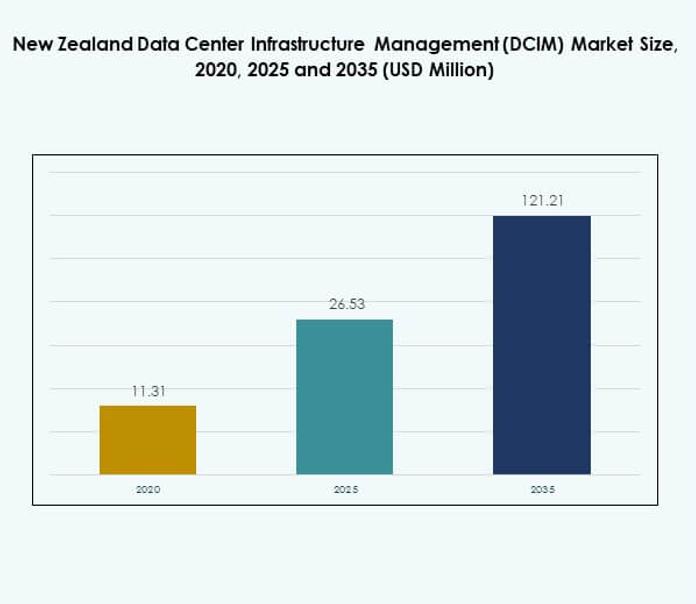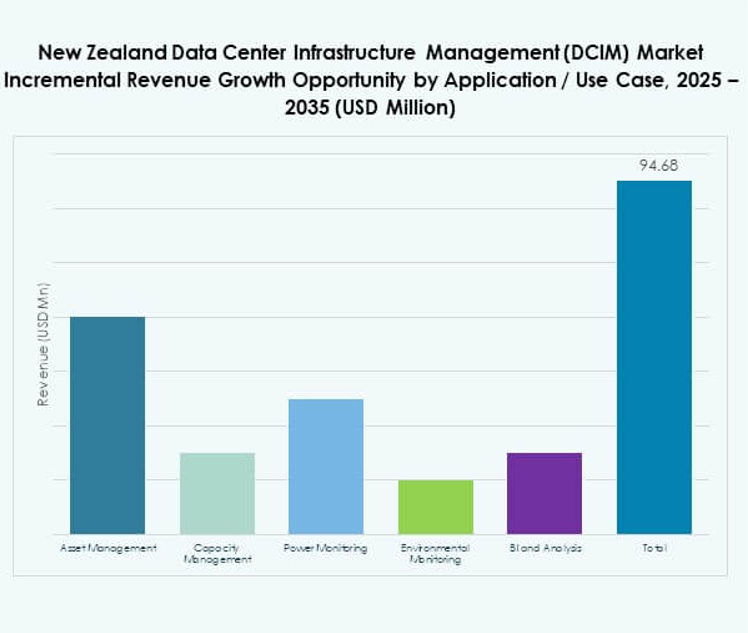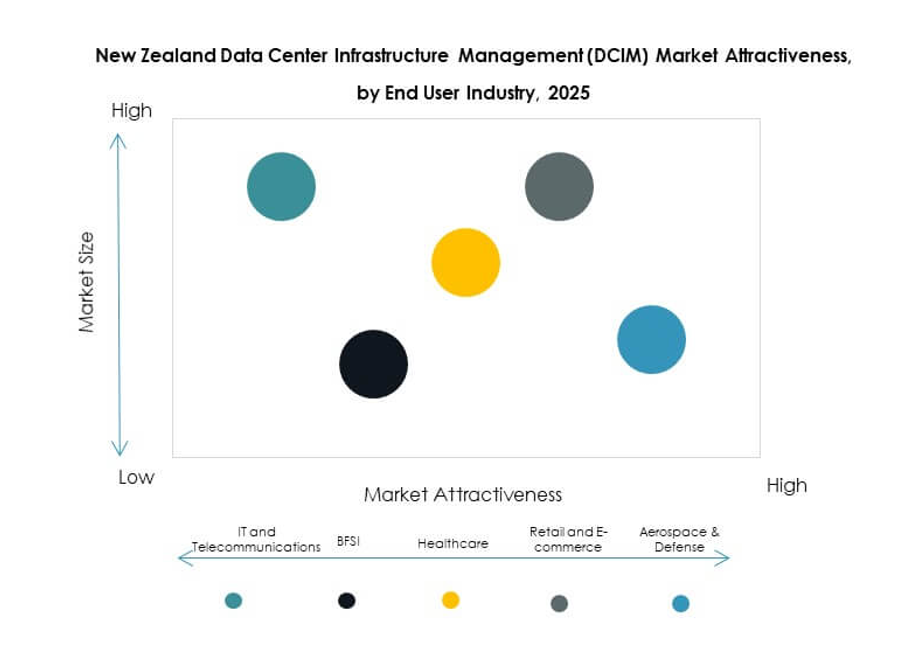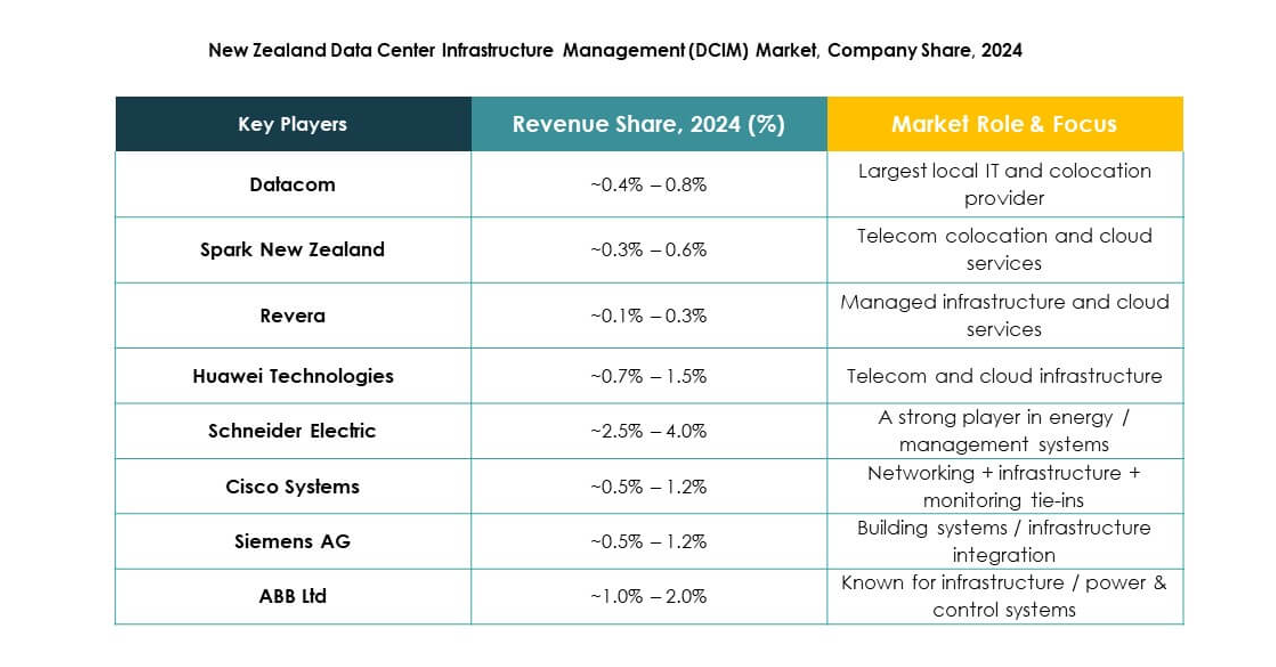Executive summary:
The New Zealand Data Center Infrastructure Management (DCIM) Market size was valued at USD 11.31 million in 2020 to USD 26.53 million in 2025 and is anticipated to reach USD 121.21 million by 2035, at a CAGR of 18.19% during the forecast period.
| REPORT ATTRIBUTE |
DETAILS |
| Historical Period |
2020-2023 |
| Base Year |
2024 |
| Forecast Period |
2025-2035 |
| New Zealand Data Center Infrastructure Management (DCIM) Market Size 2025 |
USD 26.53 Million |
| New Zealand Data Center Infrastructure Management (DCIM) Market, CAGR |
18.19% |
| New Zealand Data Center Infrastructure Management (DCIM) Market Size 2035 |
USD 121.21 Million |
The market is driven by rising adoption of AI, automation, and advanced monitoring tools that enhance efficiency and sustainability in data centers. Innovation in hybrid and edge deployments supports dynamic workloads, while enterprises increasingly prioritize energy optimization and compliance. The market holds strategic importance for businesses and investors as it enables resilience, scalability, and stronger returns through improved visibility and operational control.
Regionally, Auckland leads due to its role as a hub for hyperscale and enterprise data centers, supported by strong connectivity and global provider presence. Wellington demonstrates steady growth through government digital initiatives and enterprise modernization. Christchurch is emerging as a regional hub for disaster recovery and business continuity, highlighting a balanced geographic expansion across the country.

Market Drivers
Adoption of AI and Automation Across Data Center Operations
The New Zealand Data Center Infrastructure Management (DCIM) Market is driven by rapid adoption of AI-powered monitoring and automation tools. Enterprises focus on predictive analytics to optimize workloads and reduce downtime. Automation improves operational efficiency while reducing manual intervention. Businesses deploy AI-driven cooling and energy management to lower costs. Predictive insights improve equipment maintenance, extending asset life cycles. Automation also supports compliance with strict industry regulations. Growing reliance on intelligent systems strengthens investor confidence. It positions the market as a critical enabler of sustainable digital growth.
- For instance, Amazon Web Services (AWS) launched its Asia Pacific (Auckland) Region in September 2025, backed by NZ$7.5 billion investment, operating multiple availability zones to support hyperscale workloads and advanced AI-driven applications across New Zealand.
Rising Demand for Cloud, Edge, and Hybrid Infrastructure
Cloud adoption and hybrid deployments strongly influence growth in the New Zealand Data Center Infrastructure Management (DCIM) Market. Enterprises demand flexible solutions to manage dynamic workloads. Cloud-based DCIM platforms enable scalability and cost optimization. Hybrid models integrate on-premises systems with cloud platforms for stronger resilience. Edge computing expansion enhances real-time performance for data-intensive industries. Enterprises view hybrid management as a long-term strategy to balance control with innovation. It creates opportunities for vendors offering unified visibility across hybrid and edge setups. This trend accelerates the strategic role of DCIM investments for digital transformation.
Increasing Focus on Sustainability and Energy Efficiency Goals
Sustainability acts as a central driver in the New Zealand Data Center Infrastructure Management (DCIM) Market. Operators focus on reducing power consumption through advanced monitoring tools. Renewable integration and green energy adoption enhance brand value. DCIM platforms track energy efficiency and ensure compliance with global standards. Businesses prioritize systems capable of reducing carbon footprints. Vendors integrate modular cooling and power optimization to cut waste. This strengthens competitive positioning in a market favoring low-emission practices. It attracts both investors and clients aligned with ESG-focused business strategies.
Expansion of Digital Transformation and Industry Modernization Programs
Enterprises in New Zealand view digital infrastructure as vital for modernization. The New Zealand Data Center Infrastructure Management (DCIM) Market benefits from government and private sector investments. DCIM adoption supports critical operations in finance, telecom, and healthcare. Businesses deploy solutions to align with growing digital services. Demand grows for advanced visibility across IT and facility assets. Rising IoT and 5G adoption reinforces demand for integrated DCIM. Strategic value lies in resilience and compliance, crucial for investors. It enables organizations to future-proof infrastructure against rising complexity.
- For instance, Chorus New Zealand launched Express Connect in June 2025, a carrier-neutral high-speed data center connectivity service offering near-instant activation within four business hours, strengthening enterprise-grade performance and supporting the country’s expanding data center ecosystem.

Market Trends
Integration of DCIM With Smart Technologies and IoT Ecosystems
The New Zealand Data Center Infrastructure Management (DCIM) Market reflects strong integration with IoT-driven ecosystems. Smart sensors provide real-time monitoring across energy, cooling, and environmental conditions. IoT connectivity improves capacity planning and asset tracking. Integration of AI enhances the ability to predict workload surges. DCIM systems increasingly incorporate robotics and automation for inspections. It boosts safety and operational efficiency for enterprises. IoT ecosystems strengthen customer trust in smart-enabled facilities. This integration drives long-term technological competitiveness within the market.
Shift Toward Software-Defined and Virtualized Infrastructure
A key trend in the New Zealand Data Center Infrastructure Management (DCIM) Market is the move toward software-defined infrastructure. Virtualization drives flexibility in capacity management and load balancing. Software-defined systems enable dynamic scaling across workloads. Businesses adopt virtualization to cut hardware dependency. Virtualized platforms improve agility in cloud and hybrid deployments. It strengthens cost efficiency while ensuring faster response times. Growing reliance on virtualization fosters advanced DCIM solutions. Vendors highlight this trend as central to next-generation infrastructure strategies.
Emergence of AI-Driven Cybersecurity Within Data Center Management
Cybersecurity integration within DCIM platforms marks a rising trend. The New Zealand Data Center Infrastructure Management (DCIM) Market shows strong interest in AI-driven security solutions. Platforms include real-time threat monitoring with automated response tools. Businesses deploy machine learning to detect anomalies across workloads. Integration supports compliance with strict data privacy regulations. It reduces vulnerability in hybrid and cloud environments. Security-enhanced DCIM platforms attract industries handling sensitive data. This trend strengthens market trust in integrated, secure management systems.
Growing Popularity of Modular and Scalable DCIM Solutions
Scalability emerges as a priority for enterprises managing complex infrastructures. The New Zealand Data Center Infrastructure Management (DCIM) Market shifts toward modular deployments. Businesses demand platforms that expand with workload growth. Modular systems enable gradual investments while maintaining resilience. They provide cost control while ensuring performance optimization. Scalability attracts SMEs entering cloud or colocation services. It enhances adoption across industries requiring flexible infrastructure growth. Vendors highlight modular design as a driver of long-term adoption trends.

Market Challenges
High Implementation Costs and Complexity of Deployment
The New Zealand Data Center Infrastructure Management (DCIM) Market faces challenges related to high implementation costs. Enterprises hesitate due to large upfront investment requirements. Smaller firms face resource constraints for advanced deployment. Integrating DCIM into legacy systems increases complexity. Enterprises require skilled staff to manage advanced platforms. Lack of expertise slows adoption among SMEs. Vendors must reduce integration barriers to expand adoption. It remains a challenge in balancing innovation with cost feasibility.
Concerns Around Data Privacy, Compliance, and Vendor Lock-In
Data privacy regulations create additional challenges for adoption. The New Zealand Data Center Infrastructure Management (DCIM) Market must comply with strict security requirements. Enterprises fear vendor lock-in with proprietary platforms. Businesses worry about limited flexibility to shift vendors. Compliance with multi-industry standards adds complexity. Managing hybrid workloads increases security challenges. Companies must balance compliance with cost efficiency. It makes vendor transparency and interoperability critical for buyers.
Market Opportunities
Expansion of Edge Computing and AI Integration Across Industries
Edge computing adoption creates strong opportunities for vendors. The New Zealand Data Center Infrastructure Management (DCIM) Market benefits from rising demand for localized processing. AI-driven insights improve latency-sensitive applications. Edge growth in telecom and retail drives need for DCIM integration. AI adoption strengthens asset performance and predictive management. Enterprises view AI-enabled DCIM as essential for digital competitiveness. Vendors with scalable solutions gain market share. It positions DCIM as a core enabler of edge transformation.
Rising Demand for Green Data Centers and ESG Compliance Solutions
Sustainability provides long-term growth opportunities for the market. The New Zealand Data Center Infrastructure Management (DCIM) Market benefits from stricter carbon emission targets. Operators demand tools for power monitoring and renewable energy adoption. Green compliance attracts international investors. Vendors integrating carbon tracking gain market trust. ESG reporting becomes an integral part of enterprise strategies. It supports greater DCIM demand across regulated industries. Sustainable operations ensure resilience in global competitive markets.

Market Segmentation
By Component
Solutions dominate the New Zealand Data Center Infrastructure Management (DCIM) Market, driven by demand for monitoring and automation platforms. Services contribute steadily with growing consulting and managed service adoption. Vendors emphasize integrated platforms combining asset, capacity, and energy management tools.
By Data Center Type
Colocation and cloud data centers lead adoption, supported by hyperscale growth. Enterprise data centers remain vital for critical workloads. Edge centers emerge with increasing demand for low-latency services. It drives adoption across industries adopting distributed infrastructure.
By Deployment Model
Cloud-based models dominate adoption in the New Zealand Data Center Infrastructure Management (DCIM) Market. Hybrid deployments grow with enterprises seeking flexibility. On-premises remain relevant for industries with strict compliance needs. Vendors expand offerings tailored to hybrid visibility.
By Enterprise Size
Large enterprises lead adoption with strong investment power. SMEs show rising interest due to modular and cost-effective DCIM platforms. It drives inclusive growth across diverse industry verticals.
By Application / Use Case
Power and environmental monitoring lead market demand. Asset and capacity management follow closely in adoption. BI and analytics gain attention for predictive and strategic decisions. The New Zealand Data Center Infrastructure Management (DCIM) Market shows balanced adoption across diverse use cases.
By End User Industry
IT and telecom dominate usage, supported by data-intensive operations. BFSI and healthcare show growing reliance on DCIM for compliance and resilience. Retail, aerospace, and energy sectors expand adoption steadily. It drives broad cross-industry penetration.
Regional Insights
Auckland as the Leading Subregion in Market Share
Auckland dominates the New Zealand Data Center Infrastructure Management (DCIM) Market with 48% share. The region benefits from hyperscale developments and global cloud provider investments. Enterprises deploy advanced platforms to support large-scale workloads. Growing demand from financial and IT industries drives adoption. Connectivity hubs strengthen regional importance. It establishes Auckland as the primary data center hub in the country.
Wellington Strengthened by Government and Enterprise Modernization
Wellington accounts for 32% share in the New Zealand Data Center Infrastructure Management (DCIM) Market. Government digitalization programs fuel demand. Enterprises adopt DCIM to ensure compliance and efficiency. Healthcare and public service sectors expand adoption steadily. Wellington attracts attention for resilient IT deployments. It positions the city as a key secondary hub for enterprise workloads.
- For instance, Spark New Zealand transferred its data center assets into DC Co in 2025, valued at NZ$705 million, creating a standalone entity to expand capacity and improve compliance monitoring for enterprise and public sector clients.
Christchurch Emerging as a Growth-Oriented Subregion
Christchurch captures 20% share in the New Zealand Data Center Infrastructure Management (DCIM) Market. It grows as a hub for business continuity services. Demand rises from regional enterprises seeking disaster recovery infrastructure. Energy-efficient data center facilities expand in the subregion. SMEs show strong adoption of modular DCIM solutions. Christchurch strengthens its role as an emerging subregional growth center. It supports balanced nationwide adoption.
- For instance, Datacom’s New Zealand data centers, including Christchurch, are powered by 100% renewable electricity through a long-term agreement with Mercury Energy and hold Toitū carbonreduce certification for verified sustainability performance.
Competitive Insights:
- Datacom
- Spark New Zealand
- Revera
- ABB Ltd.
- Cisco Systems, Inc.
- Eaton Corporation
- Huawei Technologies Co., Ltd.
- Schneider Electric SE
- Siemens AG
- Others
The competitive landscape of the New Zealand Data Center Infrastructure Management (DCIM) Market is shaped by both local and global players. Datacom, Spark New Zealand, and Revera strengthen domestic presence through tailored cloud and colocation services. Global technology leaders such as Schneider Electric, Huawei, Cisco, and Siemens provide advanced DCIM platforms with integrated automation, energy monitoring, and cybersecurity features. ABB and Eaton emphasize power optimization and sustainability-focused solutions. Competition is defined by innovation, partnerships, and ecosystem integration. It demands strong investments in AI-driven platforms, scalable solutions, and energy-efficient infrastructure to meet evolving enterprise requirements and regulatory expectations. Vendors prioritize hybrid and cloud-enabled models, creating opportunities to expand influence across industries while addressing demand for compliance, performance, and resilience.
Recent Developments:
- In September 2025, Amazon Web Services (AWS) made a significant move by launching the AWS Asia Pacific (New Zealand) Region, greatly enhancing the country’s cloud infrastructure capabilities. AWS plans to invest over NZ$7.5 billion to develop, connect, operate, and maintain local data centers, supporting an average of 1,000 full-time jobs annually and adding roughly NZ$10.8 billion to New Zealand’s GDP.
- In August 2025, Spark New Zealand entered into a strategic agreement to sell a 75% interest in its data center business to Pacific Equity Partners (PEP), with the asset valued at up to NZ$705 million. Spark will transfer its data center assets into a new standalone entity called DC Co, which will have its own board and management team.
- In June 2025, Chorus New Zealand launched Express Connect, a carrier-neutral, high-speed data center connectivity service. This product is designed for immediate deployment, offering near-instant activation within four business hours at key data centers. The initiative reflects Chorus’ commitment to improving enterprise-grade performance and accelerating service delivery for New Zealand’s growing data center ecosystem.
- In June 2025, Datacom announced a strategic partnership with Amazon Web Services (AWS) to accelerate cloud migration and business modernization for customers in Australia and New Zealand. This partnership focuses on deploying generative AI solutions, such as Amazon Q Developer and AWS Transform, aiming to help enterprises upgrade legacy systems to cloud-native architectures and streamline operations with AI-powered efficiencies.



